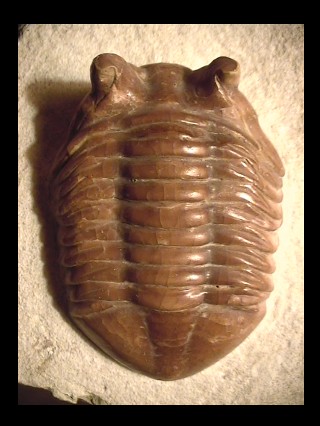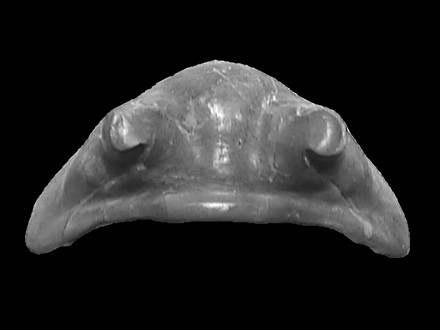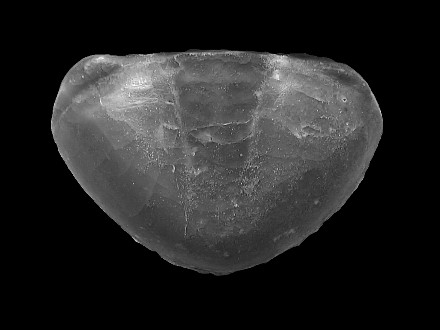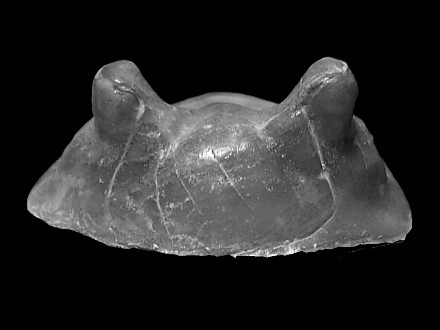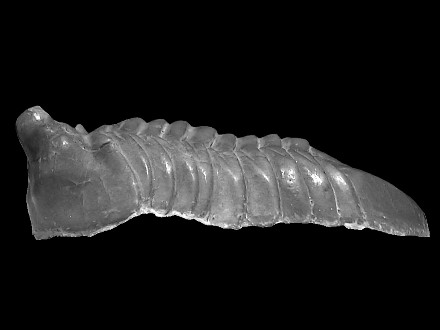|
Order
|
Asaphida
|
SALTER 1864
|
Order including 1/5 of all the species of Trilobites,
it mostly regroup librostoms of various morphology, in which the most advanced
families do present a ventral median suture early visible in the ontogeny
( "asaphoïd" protaspid larvæ).
Occurrence : Middle-Upper Cambrian boundary to upper Ordovician-lower
Silurian.
- Cephalon : Opisthoparian.
- Often equal / subequal to pygidium (e.g., Asaphoidea), but some not
so (e.g., Trinucleioidea).
- Usually with a high degree of cephalic effacement so glabellar furrows
are faint or not visible.
- Eyes usually large (some forms secondarily blind).
- Preoccipital glabellar tubercle in late forms.
- Cephalic doublure often wide, with terrace ridges.
- Librigenæ are typically separated by a median ventral suture.
- Dorsal anterior facial sutures often curve adaxially to meet in front
of the glabella.
- Hypostome conterminent or impendent, with only primitive forms (e.g.,
the Anomocaroidea) natant.
- Thorax : Typically 5 – 12 segments, but 2 - 3 in a few Trinucleioidea,
13+ in some Anomocaroidea, up to 30 in an Alsataspidid (Trinucleioidea).
- Pygidium: Typically large (subisopygous to macropygous).
- Wide doublure.
|
|
Superfamily
|
Asaphoidea
|
BURMEISTER 1843
|
Occurrence: Middle Cambrian to Ordovician.
- Cephalon : Preoccipital glabellar tubercle.
- Glabella elongate, subparallel to tapering forward.
- Defined occipital ring.
- Curved, apostrophe-like pair of basal glabellar furrows isolated within
glabella.
- Hypostome conterminant, fixed to the doublure (rarely impendent)
- Thorax : 6 - 9 segments, typically 8.
- Pygidium : Typically rounded.
- Typically without spines, sometimes with a terminal spine or pair
of spines (e.g., Thysanopyginae).
|
|
Family
|
Asaphidæ
|
BURMEISTER 1843
|
Family tends toward loss of apparent segmentation of cephalon and pygidium,
obsolescence of axial furrows and deep notching of posterior margin of
hypostoma.
- Cephalon : Librigenæ separated anteriorly by a median
suture.
- Asaphoïd with well defined to obsolete glabella, considerably
longer than frontal area.
- Lateral glabellar furrows mostly weaks or absent.
- Most genera with distinct glabellar tubercule.
- Eyes generally somewhat distant from axial furrows.
- Faint, almost obsolete eye ridges only know in 2 genera.
- Doublure commonly broad.
- Genal spines generally short and with a wide basis.
- Posterior margin of hypostoma varying from pointed (later forms) to
deeply notched and/or with panderian openings.
- Thorax : 8 segments.
- Pleural furrows generally diagonal, if present.
- Panderian organs developped as notches or separate openings, but absent
in some (e.g., Ogygiocaridinæ, Symphysurininæ).
- Pygidium : External margin varying from rounded to pointed.
- Some genera with terminal spine.
|
|
Subfamily
|
Asaphinæ |
BURMEISTER 1843
|
- Cephalon : Glabella commonly expanded in front of eyes.
- Posterior lateral furrows commonly strong, obliquely directed, mostly
deeper than part of axial furrows laterally delimiting posterior lateral
glabellar lobe.
- Glabellar tubercle situated immediately in front of occipital furrows
or of area corresponding to this furrow.
- Posterior border furrow generally distinct.
- Panderian organs developped as notches or separate openings.
- Anterior wings of hypostoma broad (tr.), more or less quadrangular
in outline.
- Posterior margin of hypostoma with deep notch (except Aulacoparia).
- Pygidium : Ribs of pleural field unfurrowed, if present, or
rarely with faint furrows.
- Posterior margin rounded.
- Without spine.
|
|
Genus
|
Asaphus
|
BRONGNIART 1822
|
Average sized trilobites. Occurence : lower and middle Ordovician, Europe
and Asia.
- Cephalon : Semi-circular or rounded-triangular.
- Opisthoparian.
- Librigenæ partially form genal angles.
- Genal angles commonly rounded.
- Posterior border of the genæ convex.
- Glabella most often pyriform, more or less convex, reaching the anterior
branches of the facial sutures.
- Facial sutures nearly blend with the anterior margin of the cranidium.
- Hypostoma has a dichotomy in the direction of the posterior parts.
- Pygidium : Isopygous.
- Semi-circular or rounded-triangular.
- Indistinct smooth lateral ribs.
- Doublurea in the anterior part does not reach rachis.
|
|
Species
|
kotlukowi
|
LESNIKOWA (?)
|
Average and large sized Asaphus (max : 13 cm). Occurence : Middle Ordovician,
Llanvirn. Body oval, convex.
- Cephalon : Triangular, moderatly convex.
- Width / length = 1,8
- Glabella pyriform, with insufficiently expressed sculpture.
- Genal angles rounded.
- Highly located eyes. Small rounded nodes at their basis, especially
noticeable on librigenæ.
- Palpebral lobes flat.
- Terrace lines on the cephalon only at the anterior part of the glabella.
- No terrace lines on librigenæ.
- Thorax : Axial part narrower than the pleural one.
- Pygidium : Rounded-triangular.
- Poorly segmented rachis.
- Narrow limb on the doublurea.
- pleural part non sculptured.
- Width / length = 1,5
|
